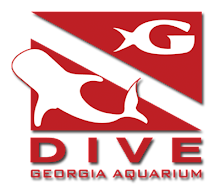The following was written by one of Dive Operation's current interns, Drew Willey:
Today I viewed the preparedness of the Aquarium in full form through what is called a “GAI diver extrication drill”.
 |
| The tender rushes to action as ADSO Windsor Gray observes |
An extrication drill here at the Aquarium involves the practice of removing a diver from an exhibit in the event of an emergency. Each exhibit here at the Aquarium has its own set of variables to be taken into account, such as proximity to an AED, the ease of access to the body of water, and the obstacles in the path to getting aid to the site. Taking these into account, the dive professionals and staff here ensure preparedness by running an extrication drill once a month at each exhibit.
 |
| The diver is removed from the water |
Today’s drill involved an extrication of a diver from the Garden Eel exhibit in Tropical Diver. We travelled to the exhibit with a Little Annie practice CPR doll and a practice AED. I watched as the Assistant Dive Safety Officer, the Tropical Diver husbandry staff, and the diver who was to be in the exhibit discussed pathways of egress and where to transport an injured diver from the exhibit. In the case of this particular exhibit, the entryway into the habitat involved a 10 foot climb up a ladder onto a small concrete topside deck and into the water. The area under the ladder was distinguished by a jumble of life support systems and cramped spaces, so like many exhibits in the aquarium, maneuverability was a potential problem. The main issue faced in the exhibit was in transporting the diver from the top deck, 10 feet in the air, to the floor below in order to start CPR and first aid procedures.
 |
| The diver is lowered to the floor |
Every dive that takes place in this building requires at least two people as surface support. The tender is the person who stays at the site and observes the divers during the entire dive. The DPIC, also known as the designated person in charge, must remain in close proximity to the site and in radio contact with the tender at all times. One of these two people may also double as the standby diver, ready to jump in if needed.
 |
| CPR is begun on the practice dummy |
When the time came the tender simulated calling security to call for an ambulance, then notified the surrounding staff, and finally began the extrication. Within seconds, GAI staff appeared and began helping the diver from the exhibit and onto the floor. Five staff members rushed up the ladder to help with the extrication of the diver while three waited below to lower the diver to the ground. The AED and oxygen were already in place by the time the diver reached the ground. When the diver was on the ground, the participants switched to the Little Annie doll. They immediately checked for signs of life, and began simulated CPR/life support on the Little Annie doll.
 |
| The group discuss the drill |
In total, the diver was extracted and life support was started in less than 4 minutes. Afterward the staff gathered together to discuss the drill and work out the problems they had encountered so as to streamline the process and become more efficient for any possibilities of true emergencies. It was an impressive show of preparedness and quality training and I am happy to have been given a chance to be a part of the Georgia Aquarium team.



No comments:
Post a Comment